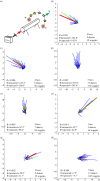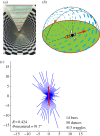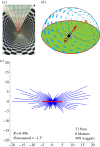Honeybee navigation: critically examining the role of the polarization compass
- PMID: 24395964
- PMCID: PMC3886325
- DOI: 10.1098/rstb.2013.0037
Honeybee navigation: critically examining the role of the polarization compass
Abstract
Although it is widely accepted that honeybees use the polarized-light pattern of the sky as a compass for navigation, there is little direct evidence that this information is actually sensed during flight. Here, we ask whether flying bees can obtain compass cues derived purely from polarized light, and communicate this information to their nest-mates through the 'waggle dance'. Bees, from an observation hive with vertically oriented honeycombs, were trained to fly to a food source at the end of a tunnel, which provided overhead illumination that was polarized either parallel to the axis of the tunnel, or perpendicular to it. When the illumination was transversely polarized, bees danced in a predominantly vertical direction with waggles occurring equally frequently in the upward or the downward direction. They were thus using the polarized-light information to signal the two possible directions in which they could have flown in natural outdoor flight: either directly towards the sun, or directly away from it. When the illumination was axially polarized, the bees danced in a predominantly horizontal direction with waggles directed either to the left or the right, indicating that they could have flown in an azimuthal direction that was 90° to the right or to the left of the sun, respectively. When the first half of the tunnel provided axial illumination and the second half transverse illumination, bees danced along all of the four principal diagonal directions, which represent four equally likely locations of the food source based on the polarized-light information that they had acquired during their journey. We conclude that flying bees are capable of obtaining and signalling compass information that is derived purely from polarized light. Furthermore, they deal with the directional ambiguity that is inherent in polarized light by signalling all of the possible locations of the food source in their dances, thus maximizing the chances of recruitment to it.
Keywords: compass; honeybee; navigation; polarization vision; waggle dance.
Figures








References
-
- von Frisch K. 1993. The dance language and orientation of bees. Cambridge, MA: Harvard University Press.
-
- Brines ML, Gould JL. 1982. Skylight polarization patterns and animal orientation. J. Exp. Biol. 96, 69–91.
-
- Wehner R. 1989. The hymenopteran skylight compass: matched filtering and parallel coding. J. Exp. Biol. 146, 63–85.
-
- Rossel S. 1993. Navigation by bees using polarized skylight. Comp. Biochem. Phys. A 104, 695–708. (10.1016/0300-9629(93)90146-U) - DOI
Publication types
MeSH terms
LinkOut - more resources
Full Text Sources
Other Literature Sources
Miscellaneous

